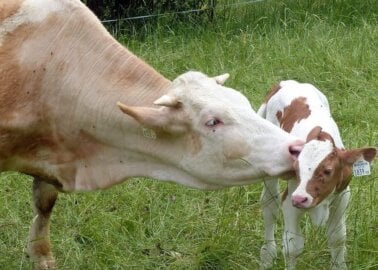The Long Road to Slaughter: Live-Animal Export
Imagine being forced onto a lorry so crowded that you barely have room to stand. You are scared and cry out for help, but no one seems to hear you. From there, it only gets worse. You don’t know it yet, but you’re about to endure a hellish journey – at the end of which you’ll be violently killed.
 Jo-Anne McArthur / Eyes On Animals
Jo-Anne McArthur / Eyes On Animals
This is the reality for hundreds of thousands of animals exported from the UK to the EU and further away for slaughter or “fattening”. This is the live-animal export industry.
What Is Live-Animal Export?
Animals like cows, pigs, and sheep – including babies and pregnant females – are transported hundreds or even thousands of miles to be killed or raised for slaughter. The conditions are filthy and dangerous. They’re forced to endure the journey in all weather extremes, stood in their own waste, causing distress, injuries, and disease.
They can be in transit for days, often without sufficient food, water, or rest. Many are trampled to death in the horrendously crowded lorries, die from exposure, or simply starve.
The rules on live export are commonly broken – a report by the European Commission recently outlined the many ways animals are being failed. They often have to endure excessively long journeys and severe crowding and may be left waiting in lorries at ports for hours and hours without being unloaded. In addition to routine suffering, long-distance live transport can also result in fires, and ships may sink, causing the suffering and deaths of large numbers of animals.
Most recently, in November 2019, a ship transporting 14,600 sheep capsized shortly after leaving port. Following many days of rescue attempts, only 180 sheep survived the disaster.
Video footage from a capsized ship in Romania with 14,000 sheep onboard. This is the reality of live export. Don’t wanna support this? Then stop eating meat. pic.twitter.com/1bECx8HOgC
— Ari Solomon (@VeganAri) November 25, 2019
This is just one tragic example of how wrong things can go when profits are prioritised over lives and animals are treated as commodities to be exploited for their flesh. How many more disasters will there be before policymakers decide that enough is enough?
And – as if the cruelty to animals weren’t enough – transporting live animals thousands of miles in cramped, filthy conditions is also a major cause of the spread of zoonotic diseases around the globe, from foot-and-mouth disease and avian influenza to SARS. Even though the COVID-19 pandemic halted global travel for humans, the shameful trade in other animals between countries continues – posing a danger to all of us.
What You Can Do
The Conservative Party’s 2019 election manifesto promised to “end excessively long journeys for slaughter and fattening”, Prime Minister Boris Johnson has said a live-export ban is a possibility, and the Department for Environment, Food & Rural Affairs has stated that one is being considered. Now is the time to put words into action. Tell environment secretary George Eustice to end this horrific cruelty.
Join PETA’s Digital Protest
For “Ban Live Exports Day” on 14 June, we’re taking the campaign to #BanLiveExports digital with Compassion in World Farming. Check out PETA’s Facebook event and mark yourself as “Interested” to save the date and hear about all the ways you can help end the cruelty of live export.



